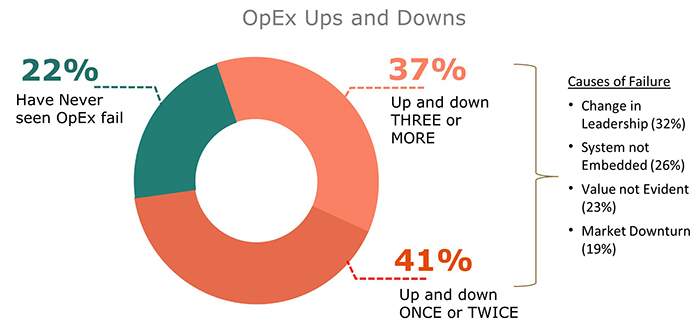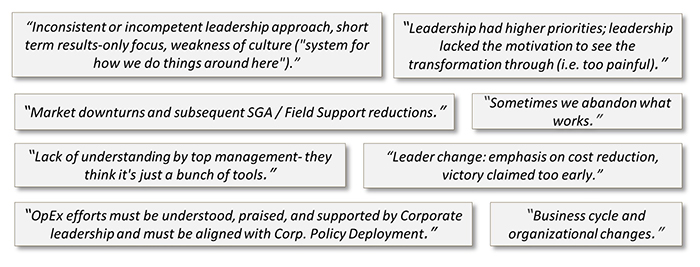Nothing is Transformed if it Cannot be Sustained
 Clients never say: “We want to transform and do better, but we don’t care if we sustain the improvements.” Clients always profess a sincere desire to sustain results. This intent is so pervasive that during the past 20 years we’ve seen the rise of Operational Excellence as a legitimate function across wide swaths of business and industry. Yet most organizations fail to realize this apparently lofty goal. Low levels of lasting success are usually explained at a tactical level, but the reasons that leaders and their organizations get it wrong goes much deeper.
Clients never say: “We want to transform and do better, but we don’t care if we sustain the improvements.” Clients always profess a sincere desire to sustain results. This intent is so pervasive that during the past 20 years we’ve seen the rise of Operational Excellence as a legitimate function across wide swaths of business and industry. Yet most organizations fail to realize this apparently lofty goal. Low levels of lasting success are usually explained at a tactical level, but the reasons that leaders and their organizations get it wrong goes much deeper.
To get a handle on what is happening and why, we explore some of the traditional norms, individual behaviors and corporate incentives that must be rethought to enable transformation success. As a first step, let’s define a few simple rules that are the foundation of any successful initiative:
Rule 1 – The Environment IS Dynamic
It’s obvious to say, but our environment is dynamic. Everything changes all the time. “Sustain” conveys a sense of holding something – a process or procedures for example – in place. It’s time to re-evaluate this concept and acknowledge that in a dynamic environment, sustain doesn’t mean we pin something to the ground. Rather, it means we stay in lock-step with a moving target, consistently and credibly adjusting and improving.
Rule 2 – Understanding Value
Value is best understood where it is created. People know the most about optimization of the things they work on. Even more important, people care more about the things they work on than the things they don’t. Failure to grasp this rule is why top-down control of improvement systems doesn’t work well and never lasts.
Rule 3 – The Leader’s Role
For any of this to work – meaning, ongoing improvement and sustainment ̶ the organization must be engaged and stay engaged. In simple terms:
More Engagement Equals Better Results
A primary (perhaps the primary) function of leadership is to compel engagement. Easier said than done, we can state flatly that engagement is an activity that can be measured and when it’s missing, overtly addressed. Experience tells us that if engagement is not compelled, it will not happen enough to deliver lasting improvement.
When everyone works on solutions with cadence, structure and discipline, peers are required to spend time together improving their deliverables along the value stream. Team dynamics increase accountability and generate performance momentum. This is the catalyst for sustainment.
Internalizing and applying these rules to any improvement system increases the odds of success. Fail to apply them and results will be sub-optimized at best. Going to the next level requires understanding the underlying organizational behaviors that come into play in the struggle to transform and sustain. Here they are:
Engagement is Not Understood or Valued
The building blocks of lasting transformation revolve around getting and keeping everyone engaged (Rule #3). Unfortunately, organizational dynamics and behaviors that deliver this are seldom experienced or even witnessed. And, “What good looks like…” is rarely part of one’s education or training curriculum. Understanding the structure of engagement so that it can be baked into the DNA of the system is essential to going beyond the “what” of transformation and getting to the “how” of it.
How to Sustain is Not Defined
In some respects it is difficult to separate transformation and sustainment. They are two sides of the same coin. But if we see engagement as the glue that holds these concepts together, it deserves a definition that is simple enough to act upon. Therefore:
The organization is engaged when you, your peers, your superiors and subordinates spend at least one hour each week actively improving the business.
This is what good looks like. When you overtly define engagement at an individual level, the behaviors and actions of it can be observed, measured and mirrored. Too often, leaders want everyone to really “get it” before they do it. Transformation happens in the reverse.
For Many, Putting Energy Into Sustaining Activities Doesn’t Pay
Transformation initiatives most often occur inside a business emergency. During these times, communication spikes, teams are formed, actions are chartered and things get done. It feels great! When it’s over, the quorum disengages, momentum wanes and everyone reverts to business as usual. The final step is recognition and reward conveyed for fixing the crisis. Big changes, big projects, and big results – these are the things that get noticed and rewarded. Everyone working on small, incremental changes and improvements for the better? … Yawn.
When the requirements for sustainment are poorly defined, not well understood and appear difficult to measure, they are avoided. Success requires broad participation, openness to new ideas and a convergence of standard, simple mechanisms aimed at improving the business. Overtly make the connection between transformation and sustainment, then weave it into the compensation, reward and recognition system. Make it safe and make it pay.
Proactive Problem Solving Might Seem Simple and Boring… and People Are Easily Distracted
The concepts and execution requirements described here are so simple that they are easily dismissed. The ideas of broad inclusion and a flatter organization often require a significant re-evaluation of organizational norms and are naturally avoided. Any distraction; the latest crisis, a new technology or any approach or method that might require less coaching and change management is a welcomed relief. Without some overt activities that demonstrate our adherence to engagement, most will shift away – usually with the tacit approval of their bosses who never got it in the first place.
It Disrupts the Status Quo
When engagement and sustainable transformation starts to occur, decisions are pushed down in order to optimize absolute value. This is a shift that challenges well-established networks that are built around personal relationships and existing dynamics. It’s disruptive. This above all others is the biggest reason for failure.
The truth is this shift frees energy that is traditionally spent on re-work, redundancy and errors. Not everyone will see it this way but when the new system of engagement is well defined and well structured, resistance is easily surfaced. Shifts in organizational and personal behavior are required. Recognize the fact that something that threatens entrenched relationships and systems succeeds only with a crystal-clear mandate, a well-defined plan and adequate coaching.
With all these obstacles, it’s no wonder the majority of organizations and leaders lament an inability to sustain their transformation and continuously improve. Start by viewing the system holistically with a keen eye on organizational dynamics, individual behaviors, simple definitions and an approach that is firmly linked to activity-based performance measures. This will help avoid rework that is exponentially more difficult the second, third, and fourth time through.
**********
For information about how to engage workgroups and push decision making down, read about Kaufman Global’s Lean Daily Management System.



 Clients never say: “We want to transform and do better, but we don’t care if we sustain the improvements.” Clients always profess a sincere desire to sustain results. This intent is so pervasive that during the past 20 years we’ve seen the rise of Operational Excellence as a legitimate function across wide swaths of business and industry. Yet most organizations fail to realize this apparently lofty goal. Low levels of lasting success are usually explained at a tactical level, but the reasons that leaders and their organizations get it wrong goes much deeper.
Clients never say: “We want to transform and do better, but we don’t care if we sustain the improvements.” Clients always profess a sincere desire to sustain results. This intent is so pervasive that during the past 20 years we’ve seen the rise of Operational Excellence as a legitimate function across wide swaths of business and industry. Yet most organizations fail to realize this apparently lofty goal. Low levels of lasting success are usually explained at a tactical level, but the reasons that leaders and their organizations get it wrong goes much deeper.